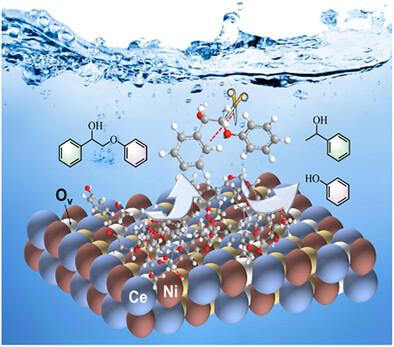结构受限Ni与缺氧CeO2用于木质素高效自转移氢解制备喷气燃料前驱体
IF 12.1
2区 材料科学
Q1 CHEMISTRY, MULTIDISCIPLINARY
引用次数: 0
摘要
木质素催化氢解为可持续航空生产芳烃燃料和烷烃燃料提供了一条很有前途的途径。然而,它的广泛应用受到依赖高压氢气和金属催化剂在氢解过程中的聚集的阻碍。自转移氢解是一种很有吸引力的不需要外源氢的解聚方法,但其催化活性低,稳定性差。在这项研究中,镍催化剂被限制在氧化铈(CeO2)纳米晶体氧空位(OV)上,在氮气气氛下有效地将天然木质素和技术木质素氢解成航空燃料前驱体。CeO2中的OV充当缺电子位,促进相邻Ni原子还原到更低的价态。这些低价的Ni物质有效地切割木质素中的C─O键,而氧空位则作为锚定位点抑制金属Ni纳米颗粒的聚集。具有氧空位的受限Ni/CeO2表现出顶级的氢解性能,桉树木质素的芳香单体收率为42%,技术木质素的收率约为20%,与商业贵金属催化剂相当。本研究为设计高效催化剂解聚原料木粉和工艺木质素制备航空燃料前驱体开辟了新的可能性。本文章由计算机程序翻译,如有差异,请以英文原文为准。

Structurally Confined Ni with Oxygen-Deficient CeO2 for Efficient Self-Transfer Hydrogenolysis of Lignin into Jet Fuel Precursors
Lignin catalytic hydrogenolysis offers a promising route to yield aromatic and alkane fuels for sustainable aviation. However, its widespread application is hindered by the reliance on high-pressure hydrogen and aggregation of metal catalysts during hydrogenolysis processes. Self-transfer hydrogenolysis is an attractive method to depolymerize without exogenous hydrogen, but suffers from low catalytic activity and poor stability. In this study, a nickel catalyst confined on cerium dioxide (CeO2) nanocrystals with oxygen vacancy (OV) is reported for efficient hydrogenolysis of both native and technique lignin into aviation fuel precursor under a nitrogen atmosphere. The OV in CeO2 acts as electron-deficient sites, promoting the reduction of neighboring Ni atoms to a lower valence state. These low-valent Ni species efficiently cleave C─O bonds in lignin, while the oxygen vacancies serve as anchoring sites to suppress aggregation of metallic Ni nanoparticles. The confined Ni/CeO2 with oxygen vacancies exhibits top-level hydrogenolysis performance with an exceptional aromatic monomer yield of 42% from eucalyptus lignin and ≈20% from technical lignin, comparable to that of commercial noble metal catalysts. This work opens up new possibilities of designing efficient catalysts to depolymerize both raw wood powder and technical lignin toward aviation fuel precursor.
求助全文
通过发布文献求助,成功后即可免费获取论文全文。
去求助
来源期刊

Small
工程技术-材料科学:综合
CiteScore
17.70
自引率
3.80%
发文量
1830
审稿时长
2.1 months
期刊介绍:
Small serves as an exceptional platform for both experimental and theoretical studies in fundamental and applied interdisciplinary research at the nano- and microscale. The journal offers a compelling mix of peer-reviewed Research Articles, Reviews, Perspectives, and Comments.
With a remarkable 2022 Journal Impact Factor of 13.3 (Journal Citation Reports from Clarivate Analytics, 2023), Small remains among the top multidisciplinary journals, covering a wide range of topics at the interface of materials science, chemistry, physics, engineering, medicine, and biology.
Small's readership includes biochemists, biologists, biomedical scientists, chemists, engineers, information technologists, materials scientists, physicists, and theoreticians alike.
 求助内容:
求助内容: 应助结果提醒方式:
应助结果提醒方式:


